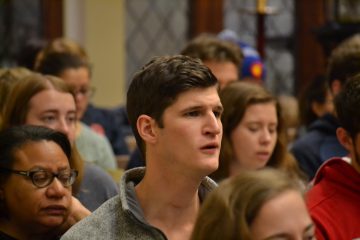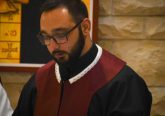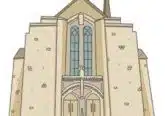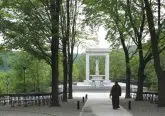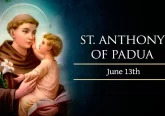Cincinnati’s Maronite community marks its centennial
Wednesday, October 20, 2010
By David Eck
ST. FRANCIS DE SALES DEANERY — St. Anthony of Padua Maronite Church marked its centennial Oct. 9 with a special Divine Liturgy celebrated by Chorbishop Michael Kail.
“It was a wonderful opportunity to be here for the 100th anniversary,” said Martha Wakim, a lifelong member of the parish. “The people here are very friendly. Everyone knows each other, and it’s like one family.”
 |
| Chorbishop Michael Kail cuts a few locks of hair in the form of a cross from the head of Donald George Jr. during the tonsure (the rite of admission into the clerical state) immediately prior to his ordination as a subdeacon. Also pictured at right is Deacon Tom Simon. (CT/Tony Tribble) |
Maronite Catholics are members of the Roman Catholic communion and are in union with Pope Benedict XVI, whom they see as head of the universal church. The leader of the Maronite Church is Cardinal Nasrallah Peter Sfeir, who is based in Lebanon. Cardinal Sfeir is currently an honorary president delegate of the Synod of Bishops for the Middle East, being held in Rome Oct. 10-24.
The Maronite Catholic Church is a worldwide Eastern Catholic Church that traces its roots to a fourth-century Syrian monk named Maron whose followers fled to the mountains of Lebanon to escape persecution. Of Lebanon’s approximately four million residents, about 40 percent are Christian, including about one million Maronite Catholics. There are approximately 100,000 Maronites in the United States and more than four million worldwide.
One of two Maronite Catholic communities in the Cincinnati archdiocese, St. Anthony of Padua has about 300 families, said Father David Fisher, pastor. About 10 families date back to the church’s founding.
“For us to reach this milestone was an overwhelming event for many of the parishioners,” said Linda Conour, who is the fourth generation of her family to belong to the church. “We know that our forefathers worked so hard many years ago.”
Records indicate St. Anthony of Padua was established in late 1910, with the first service being held in a former church on West Third Street near a Pennsylvania depot. The church moved to a former residence on Third Street in 1922 under a 99-year lease.
The parish was served by Maronite priests until 1939, and archdiocesan priests celebrated Sunday liturgies until 1948, when the late Msgr. Joseph Abood came to Cincinnati from Lebanon and was appointed pastor. He served the church for the next 40 years.
 |
| James George, left, and his father, Darren, attend the centennial celebration at St. Anthony of Padua Maronite Church. Darren George’s brother, Donald George Jr., was ordained as a subdeacon during the Divine Liturgy. (CT/Tony Tribble) |
“He made the parish a very strong parish when he was pastor. He laid the foundation for what the church really is today,” said Conour. “So many of the older parishioners talk so fondly of him and how much fun they had with him.”
Under his early leadership the parish grew and purchased the Third Street property. The church was forced to move in 1955 to make way for a roadway extension project. Msgr. Abood led St. Anthony’s in purchasing a building on Victory Parkway that was originally built as a Jewish synagogue in 1915 and sold to the Church of Jesus Christ of Latter-day Saints in 1941.
The parish celebrated liturgies in the Cathedral of St. Peter in Chains for about a year while the new building was renovated. An adjacent house was purchased to serve as a rectory, but has since been rebuilt. Over the years adjoining houses were purchased to expand parking facilities. In 1981, a Maronite Center capable of holding 500 people was dedicated by then-Archbishop of Cincinnati Joseph Bernardin and Bishop John Chedid. The center was named after Msgr. Abood.
When Msgr. Abood retired in 1987, about 400 parishioners and friends honored him at a banquet.
“He was the most beloved person,” said Father Fisher. “He was a giant.”
Founding parishioners typically came to Cincinnati to escape Ottoman Empire persecutions prior to World War I, while more recent families fled the civil war in Lebanon in the 1970s and 1980s, Father Fisher said. Most of the parishioners are descendants from Lebanon, but the church also has Palestinian and Jordanians members.
While basic elements of the liturgy are similar, Maronite Catholics use Aramaic, Arabic and English. Their liturgies also tend to be a little more elaborate, Father Fisher said.
“I love the chanting in Aramaic,” said Ann Kuhlman, a Roman Catholic who works as the parish secretary but attends the Maronite liturgy during the week. “It gives us a unique spirituality that attracts people.”
The anniversary weekend also included the ordination of Subdeacon Donald George Jr. A subdeacon is the highest of minor orders in many Eastern-rite churches, higher than a reader, but lower than a deacon.
David Eck can be reached at [email protected].



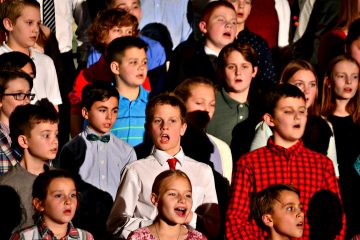
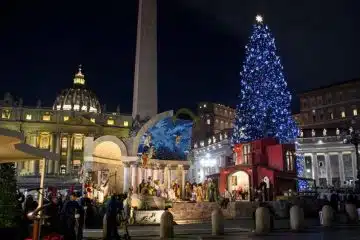
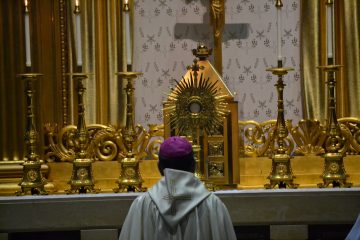
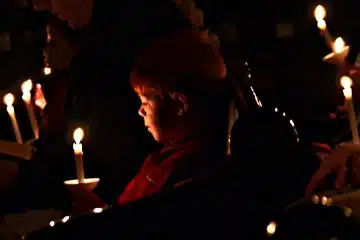
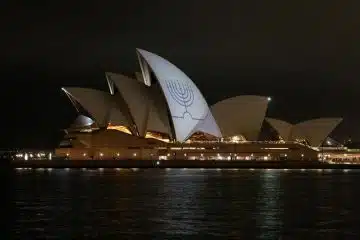
![The night is advanced, the day is at hand. Let us then throw off the works of darkness [and] put on the armor of light Romans 13:12 Rorate Mass Old St Mary (CT Photo/Greg Hartman)](https://www.thecatholictelegraph.com/wp-content/uploads/2018/12/DSC_0569a-360x240.jpg)
